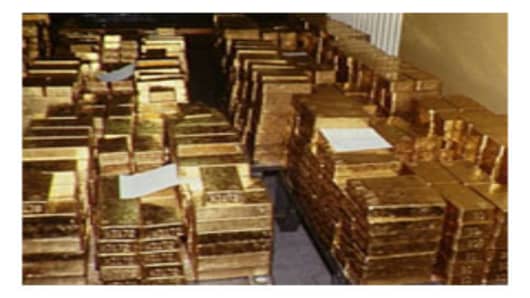Gold pared most of its gains Monday, as investors took profits from a rally to record highs above $1,030 and a sharp drop in oil prices lowered the metal's appeal as an inflation-hedge.
Spot gold was quoted at $1,006.80/1,007.00 an ounce after falling to a low of $998.90. Earlier, it hit a record high of $1,030.80, against its close of $996.90/997.70 in New York late on Friday.
Other key precious metals fell, with platinum declining more than 4 percent to a 1-week low and palladium slipping over 6 percent in a broad-based sell off, analysts said.
"It looks as though there is just profit-taking after a great run. There could be selling to meet margin calls as equities tank,'' said David Thurtell, analyst at BNP Paribas.
European shares fell 4.1 percent to their day's lows in afternoon trade, led lower by banks as investors worried about contagion from a fire sale of Bear Stearns.
JPMorgan Chase said late on Sunday it would buy Bear Stearns for just $2 a share -- more than 90 percent below its price at Friday's close.
The deal underlined the risks banks are facing as the U.S. mortgage crisis deepens and the rock-bottom price raised questions over valuations across the industry. To read more please double click on.
"Oil clearly led the way down,'' said David Holmes, director of metals sales at Dresdner Kleinwort Investment Bank.
"The market is incredibly jittery because of the financial situation,'' he added.
Oil plunged from a record high as a part of wider commodity sell-off sparked by growing concern over the health of the world's largest economy.
Gold is seen as a hedge against oil-led inflation, while the metal often moves in the opposite direction of the dollar.
The dollar pared losses after tumbling to record lows against the euro earlier in the day, when liquidity-boosting measures launched by the Federal Reserve over the weekend failed to quell worry about the health of the U.S. financial sector.
Market Gets Support
But some analysts said gold was likely to get support from the financial market concerns and a weaker dollar.
The dollar earlier reacted to the Fed taking emergency measures to stem the fast-spreading financial crisis, cutting its discount rate by 25 basis points to 3.25 percent on Sunday and opening up discount window lending to major investment banks, a tool not used since the Great Depression.
Investors expect the Fed could slash overnight rates by up to 125 basis points by the end of its meeting on Tuesday.
An interest rate cut tends to weaken the dollar, which in turn helps bullion prices.
"What is really important for this week is to see what the Fed is doing,'' said Michael Widmer, analyst at Lehman Brothers, saying financial jitters would underpin the market. "The current macro-economic backdrop, particularly in the United States, is bringing new buyers into the gold market.''
Gold hit $850 an ounce in 1980, lifted by a combination of high inflation linked to strong oil prices, the Soviet invasion of Afghanistan and the impact of the Iranian revolution.
After adjusting for inflation, the 1980 high is equivalent to $2,119.30 an ounce at 2007 prices. The average for the whole of 1980 has been calculated at $1,532.14, according to precious metals consultancy GFMS Ltd.
"As long as financial markets are driven by angst and panic, gold is likely to remain firm,'' said James Moore, precious metals analyst at TheBullionDesk.com.
In other metals, silver set a new 27-year high at $21.24 before slipping as low as $19.92. It was last quoted at $20.28/20.33 an ounce, against $20.63/20.68 in New York.
Platinum fell over 4 percent to $1,975 an ounce before rising to $1,990/2,000, against $2,070/2,080 on Friday. Palladium declined to $487/482 an ounce from $509/514.


